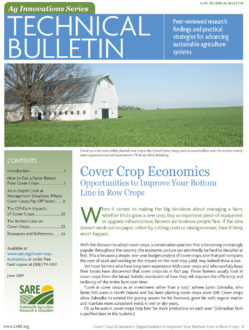In the 2016–17 National Cover Crop Survey, 59% of farmers reported having herbicide-resistant weeds on some of their fields, and that percentage is expected to continue rising. Due to the rapid spread of herbicide-resistant marestail, Palmer amaranth and waterhemp, along with other herbicide-resistant weeds, farmers are having to spend more on herbicides while often getting worse results. In some situations, entire crop fields have been abandoned to weeds, particularly in the South. Even where partial control of these challenging weeds is obtained, yield losses occur and the crop delivered to the grain elevator may be docked substantially in price for weed seed contamination. This problem is only going to get worse in many areas. For example, a weed scientist from Southern Illinois University recently reported that some marestail weeds in Illinois are now showing resistance to four different classes of herbicide chemistry [14].
While no single crop management strategy can completely resolve the situation with herbicide-resistant weeds, cover crops are proving to be an effective tool in farmers’ toolboxes for controlling these weeds. For example, when asked if cereal rye was helping with herbicide-resistant weed control, 25% of the farmers in the SARE/CTIC survey said it always helped and 44% said it sometimes helped, while 31% said they saw no difference. In some cases, the farmers were able to get by with just one application of post-emergence herbicide instead of two, or were able to go with a less-expensive residual herbicide chemistry when they added cover crops to their weed control strategy.
This potential savings in herbicide costs will not necessarily pay for the full cost of cover crop seeding, but when combined with possible yield advantages and avoiding dockage fees or even yield losses at harvest, it may provide a positive return in the first year or two of cover crop use. More specifically, using cereal rye biomass to get by with one less pass of post-emergence spray, along with lower-cost residual herbicides, can lead to savings of $35 per acre or more when an herbicide-resistant weed infestation is severe and would otherwise cause yield loss and potential weed seed dockage in harvested grain.
Where the cover crop investment is most likely to pay is when cereal rye and/or other covers grow long enough to create a biomass blanket that reduces weed seed emergence and growth. If the cash crop is “planted green” into the cover crop (seeded while the cover crop is still living), weed control is usually increased, particularly if planting in a no-till fashion with significant rye residue providing a weed protection mat on the soil surface. Recent work by the University of Nebraska has shown that cover crop rye biomass of 3,300–3,600 pounds per acre had a dramatic impact on weeds in corn, reducing both weed biomass and weed density by 90% [1]. (Note: If using cereal rye before corn, adjustments to your nitrogen fertilization strategy are recommended.)
Nebraska results with soybeans were more variable, depending on the amount of cover crop growth, but higher cover crop biomass generally led to better weed control. University of Wisconsin researcher and SARE grantee Erin Silva has found that allowing rye to accumulate 8,000 pounds of aboveground biomass, such as occurs with a dense stand of rye at flowering stage, is important when roller-crimping it for organic weed control in soybeans. Getting a large amount of biomass from rye may require boosting the cereal rye seeding rate, an extra cost of $5–$10 per acre.
Snapshot: The financial impact from herbicide-resistant weeds
Cover crops can pay off in year one for soybeans and in year two for corn, assuming savings of $27 per acre from using cover crops when a substantial or severe herbicide-resistant infestation is occurring. Using the calculations summarized in Table 4 for corn, the increased net profit from cover crops average -$4.36, $28.42 and $44.90 per acre after one, three and five years of planting a cover crop. Using the calculations summarized in Table 5 for soybeans, the increased net profit from cover crops average $3.45, $27.42 and $37.18 per acre after one, three and five years. (See tables 4 and 5 for details.)
The $27 per acre savings is based on a comparison of using cover crops with an herbicide program to deal with herbicide-resistant weeds versus using herbicides alone. Keep in mind that the occurrence of herbicide-resistant weeds normally drives up overall herbicide costs, as more expensive residual herbicides are used. Oftentimes an extra post-emergence herbicide treatment is employed (making a second or third post-emergence application). Specifically, the $27 figure is based on a savings of $12 per acre due to one fewer post-emergence spray (assuming Roundup Powermax at $4.50 per acre plus $7.50 per acre application cost) and $15 per acre for a lower-cost residual herbicide chemistry.
This analysis assumes that a farmer who uses cover crops to combat herbicide-resistant weeds would still apply both residual herbicides and at least one or two post-emergence herbicide passes to deal with them. The difference that a cover crop can make in this situation is to provide enough weed control that the farmer can avoid buying the more-expensive herbicides that would otherwise be required in order to deal with an escalating weed problem. There may also be additional savings from not having dockage fees for weed seed contamination in the harvested grain, and from being able to buy less expensive commodity seed (such as using Roundup Ready soybeans as opposed to new varieties that have stacked traits for resistance to both Roundup and dicamba).
